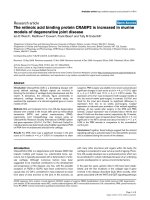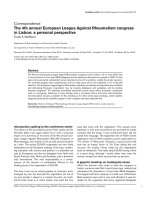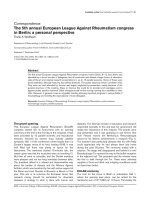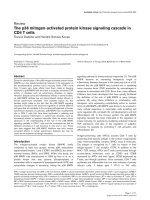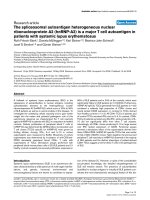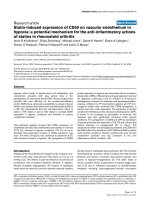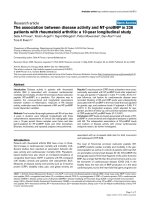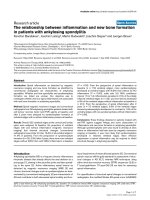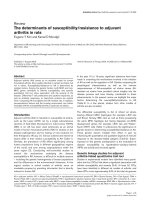Báo cáo y học: "The 5th annual European League Against Rheumatism congress in Berlin: a personal perspective" ppsx
Bạn đang xem bản rút gọn của tài liệu. Xem và tải ngay bản đầy đủ của tài liệu tại đây (579.52 KB, 4 trang )
ACR = American College of Rheumatology; EULAR = European League Against Rheumatism; ICC = International Congress Center.
Available online />The grand opening
This European League Against Rheumatism (EULAR)
congress started like its forerunners with an opening
ceremony at the end of the first day of the congress. It had
been preceded by 12 parallel scientific and educational
sessions followed by several drug industry satellite
symposia. Hall 1 of the conference center boasts that it is
Europe’s largest venue of its kind, seating 5008. It was
well filled but there was plenty of space for the
latecomers. The ceremony started 15 minutes late; the
reason given was that the musicians were out smoking (!).
But then all went to schedule, and the Dvor
v
ák melodies
were pleasant and not too long interludes between talks.
The president talked in a relaxed and statesmanlike way
about the burden of disease and the Alliance Against
Arthritis, which was launched by him with active support of
the Bone and Joint Decade in Brussels in March of this
year. One aim is to convince the European Union that
research money should be earmarked for rheumatic
diseases in analogy to what is done with cancer and
diabetes. The German minister of education and research
responded favorably to this and said her government did
realize the importance of this initiative. The awards were
duly presented, and it was gratifying to see Kimmo Aho
from Finland receive the Meritorious Rheumatologist
award for his lifetime achievements in research (Fig. 1).
The recipient was particularly pleased that his wife finally
could appreciate why he had always been late home
during the past 50 years. The ceremony ended with a
surprise. The stage wall disappeared and behind it a mini
Brandenburger Tor opened the way to the buffet reception
in the adjacent hall. The president and the minister were
the first to walk through the Tor. There were unlimited
supplies of food and drink, and mingling conditions could
not have been better.
EULAR economy
The cost for the venue in Berlin is substantial. Hall 1,
where the opening took place, can be rented for the
handsome sum of €17,880 per 12 hours. Fortunately the
Correspondence
The 5th annual European League Against Rheumatism congress
in Berlin: a personal perspective
Frank A Wollheim
Department of Rheumatology, Lund University Hospital, Lund, Sweden
Corresponding author: Frank A Wollheim,
Published: 1 December 2004
Arthritis Res Ther 2005, 7:E1 (DOI 10.1186/ar1474)
© 2004 BioMed Central Ltd
Abstract
The 5th annual European League Against Rheumatism congress, held in Berlin, 9–12 June 2004, was
attended by a record number of delegates from all continents and offered a large choice of education,
state-of-the-art and original research presentations in up to 15 parallel sessions. Some of these were
poorly attended, although featuring top-ranked abstracts. The poster sessions remain a problem child.
They were not well attended by viewers and largely neglected by presenters, mainly because of the
general structure of the meeting. Ways to improve this could be to provide lunch packages and to
appoint poster session chairmen. Other changes would involve moving morning hour satellites to other
slots. However, in general it was an enjoyable meeting showing important progress in various fields of
rheumatology and meeting the expectations of most delegates.
Keywords: American College of Rheumatology, European League Against Rheumatism, poster sessions,
rheumatology congress, satellite symposia
Arthritis Research & Therapy Vol 7 No 1 Wollheim
congress had over 9000 delegates paying between €800
and €1000 depending on the time of registration. This
again included a one-year subscription to the EULAR
journal Annals of the Rheumatic Diseases, and also
access to all educational events, unlike the American
College of Rheumatology (ACR), which charges extra for
these benefits. The biennial Scandinavian Congress of
Rheumatology held in August 2004 charged €450–600.
So in comparison €800 is expensive but not outrageous.
€7,200,000 was of course not the only revenue for
EULAR. There were 22 industrial satellites this time and a
large number of commercial exhibitors. No doubt this
event is generally accepted as the major marketing event
of the year in Europe, if not worldwide. Judging from this,
EULAR is in good economic health. The secretariat in
Zurich consists of only three individuals: Fred Wyss, the
executive director, Ernst Isler, the congress coordinator,
and Mrs Elly Wyss, the education program coordinator
and accountant. One must admire the efficiency of this
secretariat and congratulate EULAR on having such an
able managing team. After 20 years in a small office, the
EULAR headquarters will next spring move into its own
more spacious venue in Zurich.
The International Congress Center in Berlin
Berlin has an excellent public transportation system
consisting of underground, city trains and buses. A one-
day ‘Pass partout’ costs €5.60. So wherever you were
staying it was easy to get to the International Congress
Center (ICC). Arriving from the underground one easily
could get the impression that the ICC was an extension of
the U-Bahn system with all its narrow passages and
directions to countless halls and rooms at numerous
levels, sometimes connected by stairs, sometimes by
escalators, sometimes only by elevators. Moving around
was good prophylaxis against deep vein thrombosis and
the ‘ask me’ personnel were very helpful. Security,
surprisingly, was a problem. I met a couple of Swedish
colleagues who had lost their wallets inside the ICC, and
told me that they were not the only ones.
The scientific sessions
To make a fair judgment on the podium sessions, one
would need a committee of some 10 individuals who
divided the sessions between themselves. I attended
some excellent sessions, the quality of which could not
have been better at any other meeting in the field. An
example was the ‘Advances in scleroderma’ session, with
several presentations of new material, both basic and
clinical. The room, Hall 10, which seated perhaps 200,
was full. People were standing along the walls of the room
and the discussion was lively. The session ended on time
only because one presenter of a drug study was not
present. It was interesting to note the strong frontline
research results presented by Swiss and Italian
investigators. In contrast, I attended part of a top abstract
session called ‘Cutting edge rheumatology’ in Hall 1,
where the opening ceremony had been held. There were
perhaps 50 individuals in attendance, and both chairmen
and presenters must have been disappointed at this
demonstration of lack of interest from the 9000 delegates.
Where were they? Some no doubt were travelling
between Berlin’s many superb museums and other sights,
but those attending the ICC had a choice of 15 parallel
sessions at the time. My advice would be a radical
reduction of the number of parallel sessions at future
EULAR congresses. This would reduce the need for
chairpersons. The redundant manpower could be used for
chaired poster discussions, for example. It makes sense to
stage top abstracts in a mixed topic session, but then one
should give the session features of a plenary. The ACR
has for years practised this at their annual meetings, and
the plenary sessions have often been dominated by novel
and outstanding presentations and lively discussions. One
or two such sessions should be feasible at the annual
EULAR congresses and would add distinction to the
scientific program.
The poster sessions – again a problem child
The structure of the meeting was similar to that in Lisbon
last year which I was not entirely happy about [1]. This
year the congress venue was adequate, although because
of its size and complicated architecture one was never
quite sure where in the compound one was located. In
Lisbon the industrial exhibitions had the prime location and
were separated from the scientific posters. This was not
the case in Berlin, where posters occupied the walls and
the exhibits the middle of a number of long halls. These
surrounded a courtyard with the Funkturm in an
Figure 1
Kimmo Aho (Helsinki, Finland), recipient of the 2004 “Meritorious
rheumatologist” award at the opening of EULAR 2004, flanked by
Ylva Lindroth and Lida Marsal (Malmö, Sweden).
arrangement reminiscent of a huge medieval castle. The
good intention was no doubt that the proximity of the
exhibits should stimulate delegates to visit the posters as
well. This did indeed work pretty well at the EULAR
meeting in Stockholm in 2002. The air-conditioned
premises in Berlin were pleasant and when I visited them
during the poster sessions lasting from 12.15 to 2.00 p.m.
there were plenty of people. However, most were busy
visiting the exhibitions. There you could engage in a variety
of interactions, usually ending in the handing out of some
gimmick or publication and bag with a fitting logo. My
impression was that fewer than one in ten of the posters
had a presenter in presence. I met also some fairly irritated
poster presenters who upon arrival at 8 a.m. were unable
to set up the posters. The exhibition area was still closed
and opened first at 9.30 a.m. From 8.15 to 9.45 a.m. every
day the only official activities were the satellite symposia,
and delegates should perhaps not be tempted to view
posters during that time. Similarly, the exhibition area
closed at 4.30 p.m. when the afternoon satellites started.
The number of posters was about 480 every day. Is there
really so much new material worth presenting? It depends
on whom you ask. Several posters I recognized from last
year’s ACR meeting. There were also poster presenters
who had more than one poster to present simultaneously
in different areas. Obviously you can only appear in one
place at a time (Fig. 2).
The effort involved in producing a good poster is not trivial.
I remember the headaches and fights preceding the
Stockholm EULAR by its president, Lars Klareskog, to
make sure that the poster sessions would be well
attended and that the panels would get enough space.
Handling costs for submitted abstracts are not negligible.
EULAR has the commendable ambition of attracting
young investigators to present their research to the critical
eyes of older colleagues. Most accepted submissions will
be presented in poster form. To make this a meaningful
exercise, both presenter and viewers/discussants must
obviously meet. Such encounters did not happen much in
Berlin, and – to be honest – most big meetings are not
very successful in this sense. One could ask whether the
poster sessions should continue at all. In previous years at
the ACR there were 2 hours every morning reserved for
sponsored breakfast and poster viewing, and these hours
were always very stimulating. The posters were manned
not only by the first author; often senior people from the
same group were present. One was ‘taken through’ the
posters and could ask nice or nasty questions: it was fun
and alive. I experienced both sides, and when presenting I
always got useful comments. Admittedly even the ACR
sessions are no longer like this.
So what could be changed? Younger and brighter brains
must have struggled with this problem. I can see a few
possible strategies for future meetings: (1) eliminate the
poster sessions altogether; (2) reduce the number of
poster presentations; (3) create several themed poster
sessions, each with a discussion leader; (4) restructure
the whole EULAR meeting to improve opportunities for
viewing posters.
The elimination of poster sessions would be a radical
Gordian knot solution and it would eliminate a lot of
useless work and frustration. Submitted and accepted
abstracts would be either podium presentations or
published in the abstract book but not actually presented.
Authors who need to show some sign of active
participation would thereby be identified, and email or
personal contacts with other investigators might follow.
There are difficulties with a more restrictive policy of
selecting abstracts for poster presentation while
maintaining the overall structure. The rejected submitters
might be discouraged from attending the meeting or from
submitting the following year. This would not happen to
the same extent if there were no posters. Abstract grading
is not always easy: the abstract writers’ formulation skill
might vary, the reviewers’ bias might influence selection,
and so on.
The third possibility would be to accept groups of themed
abstracts and lump 20–30 of them into predefined actual
poster sessions at which a discussion leader would give
each presenter three to five minutes to present the
essentials, whereupon questions could be asked for some
minutes. Several such sessions could be arranged, for
example lasting 2 hours. They would take place in front of
the posters, and chairs could be provided. This format has
Available online />Figure 2
Eric Matteson (Rochester, MN, USA) discussing a poster with Carl
Turesson (Malmö, Sweden) in front of one of the few manned posters
in Berlin.
worked well at recent smaller meetings I have attended,
but would probably be impracticable at a meeting of this
size. However I am informed that this format has been very
successful even at a recent meeting of EULAR size. This
would be my favorite recommendation.
So what could one learn from the successful poster
sessions in Stockholm in 2002? Probably the provision of
free lunch boxes in the poster area, fewer posters and
perhaps less attractive industrial exhibitions contributed.
The lunch box option would be worth considering next
time. And assigned chairmen would be equally important.
A stricter policy of accepting only abstracts of
unpresented and unpublished work would also be healthy.
I not only noticed several ‘old’ posters, but also listened to
some podium presenters telling the meeting of published
drug trials.
Other thoughts for some changes at future
EULAR congresses
The annual EULAR congresses are now established along
with the ACR meetings as the most important congresses
in our specialty. This is attributable to the vision, skill and
dedication of the EULAR leaders in recent years. It is good
for rheumatology and helps in implementing recent
therapeutic advances. The strength of EULAR carries
possibilities as well as dangers, among them the issue of
conflicts of interest. Good relations with industry must not
interfere with credibility and the building of equally good
relations with patients and authorities. From what I could
see, EULAR is performing well in balancing between
interests, and it is using money gained by the congresses
for good purposes. In 2004, EULAR is spending
€765,000 on education and professional development
and in 2005 this figure will be €1,700,000 (Fred Wyss,
personal communication). Among these is a visiting
professorship program. One should never change a
winning team. But there is always room for improvement.
The heart of the matter rests with the relation with
industry. Congresses are industry, and industry is driven
by profit. The congress organizer must make money.
EULAR’s main source of income is the surplus. The drug
and other product industry provides most of the money
and must be convinced that this money is well spent and
will satisfy stockholders. It would be hypocritical to deny
the fact that the present structure of the annual EULAR
congress is not the result of a compromise between
EULAR and industry. The result is 2 × 1.5 = 3 hours of
industry time and 2 + 1.5 + 1.5 = 5 hours of proper
congress time per day. The 1 hour and 45 minutes for
poster sessions and lunch and exhibitions can be
considered neutral or divided. These proportions can be
considered fair or unfair, but the result is that the congress
program is compressed in time and expanded horizontally,
with attenuated audiences and disappointed presenters.
I would urge the planners to concentrate future satellites
on the time after 4.30 or 5.00 p.m. and during periods
before and after the meeting. This would give two
additional prime morning time sessions for the congress
program. If the time for the podium sessions cannot be
expanded, the organizers need to reduce the number of
sessions. The aim of covering every subject every year is
untenable. The featured top posters deserve prime
exposure at the EULAR meetings, perhaps chaired by the
program committee chairman or some other. But the issue
of allotting prime satellite time on both mornings of the
two main congress days must be reassessed. In the end it
would perhaps be to the advantage of both EULAR and its
industrial partners.
Competing interests
The author(s) declare that they have no competing interests.
Reference
1. Wollheim FA: The 4th annual European League Against
Rheumatism congress in Lisbon: a personal perspective.
Arthritis Res Ther 2004, 6:E1.
Arthritis Research & Therapy Vol 7 No 1 Wollheim

